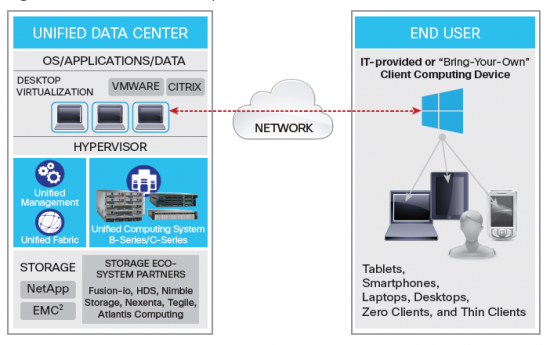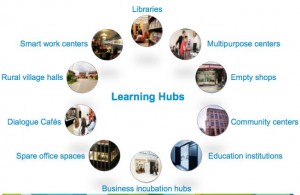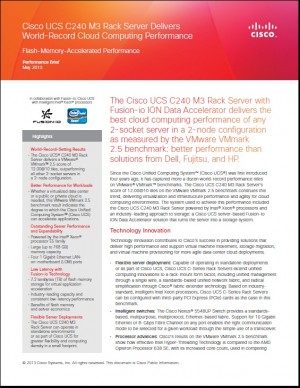Desktop Virtualization On Your Terms – Flexibility and Choice with Architectures That Fit
I recently had the opportunity to host several customers in a roundtable discussion, exploring their experiences in deploying desktop and application virtualization, the challenges encountered, and the benefits they’ve reaped. It was an engaging dialog with organizations spanning mid-market, enterprise to large service pr ovider environments deploying either Citrix XenDesktop or VMware Horizon View desktop virtualization software. In case you missed it, you can check out the event here. I mention this because it provides a valuable backdrop to some important news Cisco is sharing today, centered on helping IT organizations (like those I met with) more quickly achieve success in VDI.
ovider environments deploying either Citrix XenDesktop or VMware Horizon View desktop virtualization software. In case you missed it, you can check out the event here. I mention this because it provides a valuable backdrop to some important news Cisco is sharing today, centered on helping IT organizations (like those I met with) more quickly achieve success in VDI.
Over the last few years, Cisco UCS has rapidly established itself as a leader among competitors with a much longer history in the server marketplace. Why is that? If you talk with anyone who’s implemented UCS in their data center, they’ll instantly tell you about the operational streamlining and simplification that UCS Service Profile Templates offer, the value of a unified data center fabric for LAN and SAN, and the performance derived from a platform that was purpose built for highly scalable, virtualized environments.
It should be no surprise then, that when organizations evaluate their options for server infrastructure to host virtual desktop workloads, the same UCS core value proposition extends nicely to desktop virtualization – the benefits of which are multiplied, in fact, given that virtual desktops can consume infrastructure resources and capacity in unique ways compared to other mission critical enterprise applications. We’ve therefore seen great response from our customers (as demonstrated in our webinar/panel discussion) when it comes to the fitness of UCS in hosting virtual desktops.
be no surprise then, that when organizations evaluate their options for server infrastructure to host virtual desktop workloads, the same UCS core value proposition extends nicely to desktop virtualization – the benefits of which are multiplied, in fact, given that virtual desktops can consume infrastructure resources and capacity in unique ways compared to other mission critical enterprise applications. We’ve therefore seen great response from our customers (as demonstrated in our webinar/panel discussion) when it comes to the fitness of UCS in hosting virtual desktops.
What we’ve come to find through our customer’s experiences, is that the vendor marketplace has traditionally taken a one-size-fits-all mentality around VDI architectures that either forces organizations to overspend CAPEX on approaches that are tuned for much larger environments, or wrestle with an economized approach that results in poor desktop user experience. Clearly, there’s a spectrum of IT implementation use cases that apply, when we’re talking VDI. Persistent desktops vs. floating, SAN in place vs. greenfield, one-hundred seats vs. tens of thousands, etc. so one size will never adequately fit all!
For this very reason, we’re expanding our portfolio of desktop virtualization solution architectures, along with the ecosystem of technology partners who are helping us accelerate the path to VDI success for environments of all sizes. While Cisco enjoys a strategic relationship with NetApp and EMC, we’re now offering desktop virtualization solutions that also include technologies from partners such as Nimble Storage, Nexenta, Atlantis Computing, Fusion-io, Tegile and others in process.
With these partners’ technologies come new capabilities that exploit key trends in the VDI and data center marketplace, including the proliferation of flash-based storage solutions, and appliance based approaches that mitigate the need for embedded SAN infrastructure and expertise (especially in smaller environments). Additionally, unlike our competitors who are narrowly focused on their own storage portfolio, Cisco can offer our customers the flexibility and choice they desire in selecting the storage technology and solution for VDI, that best fits their environment.
I encourage you to learn more about this exciting new portfolio of architectures by checking out the assets below.
Please also check out the webinar “Customer Insights: Desktop Virtualization On Your Terms”
Our featured guests include:
- Mark Balch, Director UCS Product Management, Cisco
- David Johnson, Principal Analyst, Forrester Research
- Charles Rosse, Baptist Memorial HealthCare
- Udaya Kiran, WiPro Technologies
- Robert Dixon, University of Colorado, Boulder
- And myself (Jim McHugh) as your Host/Moderator
Check it out and let me know what you think in the Comments section!
Share:


 ovider environments deploying either Citrix XenDesktop or VMware Horizon View desktop virtualization software. In case you missed it, you can check out the event
ovider environments deploying either Citrix XenDesktop or VMware Horizon View desktop virtualization software. In case you missed it, you can check out the event  be no surprise then, that when organizations evaluate their options for server infrastructure to host virtual desktop workloads, the same UCS core value proposition extends nicely to desktop virtualization – the benefits of which are multiplied, in fact, given that virtual desktops can consume infrastructure resources and capacity in unique ways compared to other mission critical enterprise applications. We’ve therefore seen great response from our customers (as demonstrated in our webinar/panel discussion) when it comes to the fitness of UCS in hosting virtual desktops.
be no surprise then, that when organizations evaluate their options for server infrastructure to host virtual desktop workloads, the same UCS core value proposition extends nicely to desktop virtualization – the benefits of which are multiplied, in fact, given that virtual desktops can consume infrastructure resources and capacity in unique ways compared to other mission critical enterprise applications. We’ve therefore seen great response from our customers (as demonstrated in our webinar/panel discussion) when it comes to the fitness of UCS in hosting virtual desktops.

CONNECT WITH US